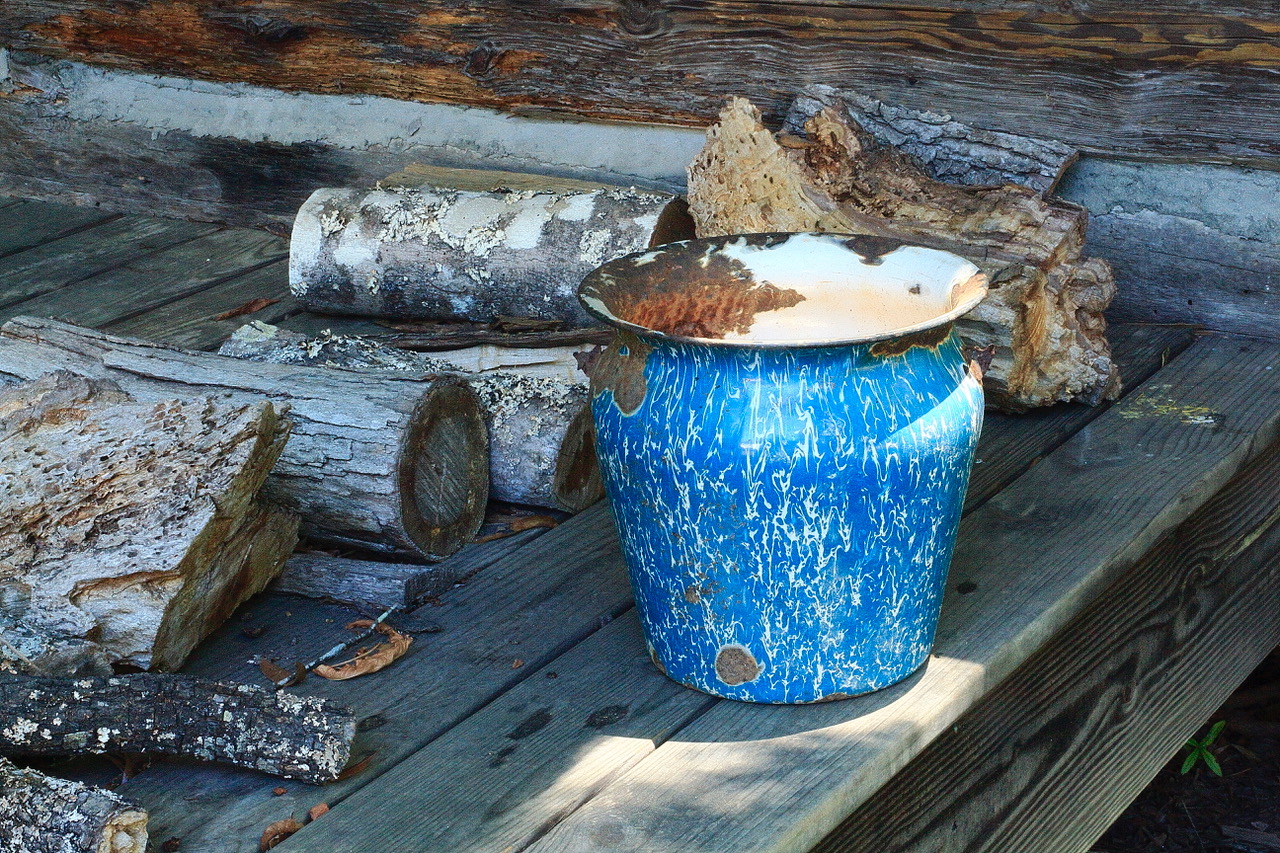Vintage Enamelware
August 10, 2022By Tom Poland
I was visiting the past at the Lincoln County History Park when I spied a graceful blue enamelware pot sitting among fire logs. Warm memories came from that cold enamelware. Yes, that forgotten pot sent me reeling through the years.
Chief among my enameled memories are chamber pots with their red rim, white body, and red handles. Many a day I spied a chamber pot, aka the “slop jar,” beneath a four-poster bed. I recall, too, dark blue pots speckled white in kitchens and considered them beautiful and practical.
The memories kept coming unabated. Besides plain glass jars, I recalled the white enameled water pitchers my grandmom kept in her old Fridge. Those graceful pitchers served water so cold it’d hurt the teeth. I just can’t imagine a plastic pitcher serving cold water. I don’t believe it can. I know it cannot. You know it too.

An enamel pot sits forgotten with its requisite rusty places where enamel broke free.
Plasticware has its problems, one being the possibility of containing toxins and the fact that it’s not as easy to clean as smooth enamelware. How I wish enamelware would go retro and usher in an enamelware renaissance. Enamelware possesses class. Plastic is crass. Plastic has synonyms, you know. Among them are fake, false, bogus, pseudo … shall I go on?
Enamelware. No matter how cautious you’d be with it, without fail something would break enamel off an old pot and it looked as though a sore festered there, a gray sore with concentric rings. Enamelware suffered ringworms you could say. Even so I loved it and love it still.
I like the rustic look a navy pot spotted white gives a kitchen. Seems perfect for a log cabin or old shack too. Campers still use enamelware. It’s lightweight, easy to clean, and doesn’t break, although it chips as we’ve noted. Somewhere in my cabinet among a million coffee mugs hides an enameled coffee cup, navy, spotted white, of course. I once used it on camping trips. As my old college roommate, Garnett, would say, “I must needs find it and use it anew.”
I remember an enamel basin Mom and Dad used in the 1960s. I recall, too, enameled sinks and tubs with those sore-like blotches where someone dropped a heavy object that shaved away a slice of enamel. Then the rust came calling.
Enamelware. I miss it. It claims, you know, to be the first mass-produced American kitchenware. Production began in the 1870s and continued through the 1930s when aluminum and other substances began to replace it. Manufacturers stamped pots, kettles, baking tins, and ladles from thin sheets of iron, steel, or aluminum, and coated them with enamel.
But what about the enamel itself? Manufacturers made enamel, or vitreous enamel from powdered glass. They fused it to a surface like metal, clay, or stone and fired it in a 2000-degree Fahrenheit oven. As the powdered glass melted, it bound to the iron and created a smooth, non-porous, non-stick finish.
Do you own any vintage enamelware? If it’s heavy and has marks and labels and is in tiptop shape, collectors might pay you a hefty sum for it. I saw where a vintage enameled muffin tin fetched $1,500.
One last thought … do you remember the white retro enameled tables of the 1950s with red trim and chrome legs? Mom and Dad had one and I see it still. Why I suspect we sat enamelware on it come suppertime. We were retro before retro was cool and we had no plastic until something called Tupperware came along. And then things began to change.
Visit Tom’s website at www.tompoland.net
Email Tom at [email protected]


















